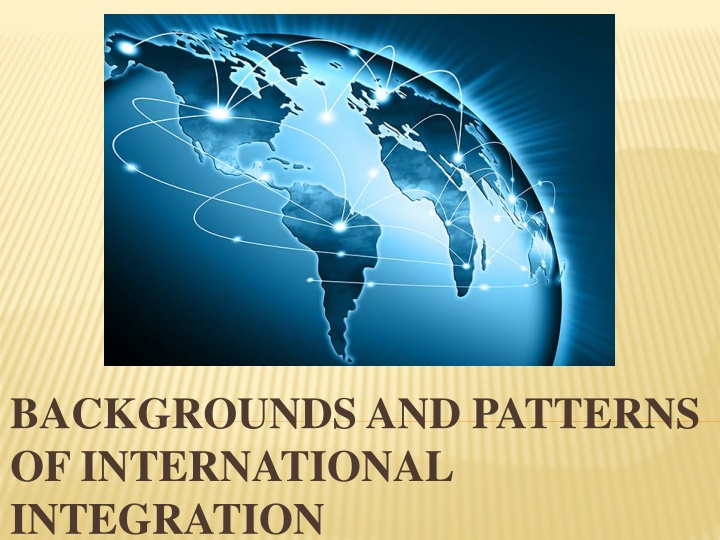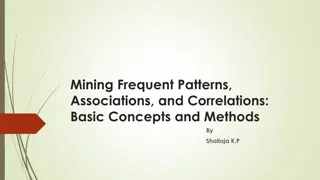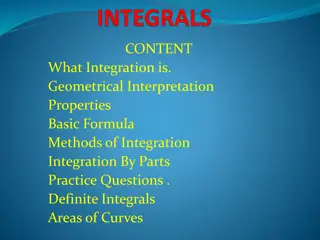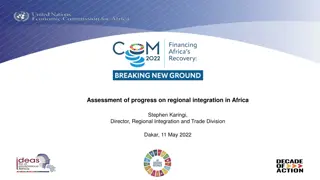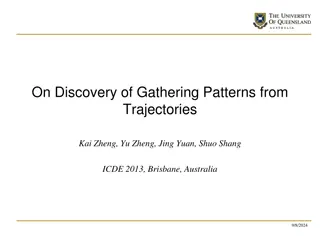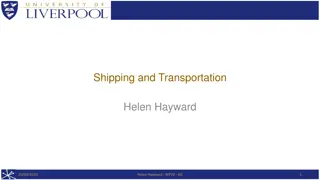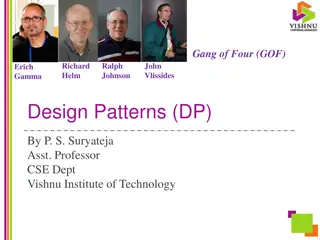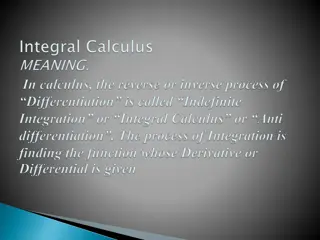Backgrounds and Patterns of International Integration
International integration involves the elimination of barriers and increasing interdependence in various aspects of society. Factors contributing to integration include cultural diversity, national interests, economic globalization, and technological progress. Principles of international relations are challenged by integration, such as independence and state sovereignty. Globalization plays a significant role in promoting integration by creating a unified global framework and common global area.
Download Presentation

Please find below an Image/Link to download the presentation.
The content on the website is provided AS IS for your information and personal use only. It may not be sold, licensed, or shared on other websites without obtaining consent from the author.If you encounter any issues during the download, it is possible that the publisher has removed the file from their server.
You are allowed to download the files provided on this website for personal or commercial use, subject to the condition that they are used lawfully. All files are the property of their respective owners.
The content on the website is provided AS IS for your information and personal use only. It may not be sold, licensed, or shared on other websites without obtaining consent from the author.
E N D
Presentation Transcript
BACKGROUNDS AND PATTERNS OF INTERNATIONAL INTEGRATION
QUESTIONS 1) International integration: definition and manifestations; 2) Backgrounds of international integration; 3) Basic patterns of international integration.
INTERNATIONAL INTEGRATION: DEFINITION AND MANIFESTATIONS Integration is a formation of an integrity of independent elements which involves combining previously independent parts. International integration is the elimination of barriers between countries and continents and increasing international interdependence in economics, politics, communication, culture, environment, etc.
INTERNATIONAL INTEGRATION: DEFINITION AND MANIFESTATIONS The most important manifestation of international integration is internationalization of economic, political, social, spiritual, and other areas of modern society, sometimes assuming the form of supranational institutions.
INTERNATIONAL INTEGRATION: DEFINITION AND MANIFESTATIONS Factors contributing to international integration: 1) Variety of cultural, civilizational, spiritual, and philosophical types in the modern world; 2) Coincidence of national interests of certain nations; 3) Economic globalization and global competition; 4) Increasing openness of national economies, liberalization, and internationalization of economic life; 5) International division of labor (IDL) and increasing interdependence of nation states; 6) Scientific and technological progress.
INTERNATIONAL INTEGRATION: DEFINITION AND MANIFESTATIONS Principles of international relations challenged by integration: 1) Independence; 2) State sovereignty; 3) Territorial integrity of a nation state; 4) Preeminence of the political dimension in international relations.
BACKGROUNDS OF INTERNATIONAL INTEGRATION Globalization as one of the most powerful stimuli for integration involves: 1) The growing importance of the external (political, economic, cultural) factors; 2) Emergence of common global area without national barriers; 3) Creation of a unified legal framework for all countries.
BACKGROUNDS OF INTERNATIONAL INTEGRATION Globalization emerged after World War II but its progress has not ended as yet and is in the focus of public attention since the 1990s. It involves: 1) IDL; 2) Internationalization of production processes; 3) Strengthening political ties.
BACKGROUNDS OF INTERNATIONAL INTEGRATION IDL first appeared in ancient times but even in the 19thcentury international exchange did not exceed 1% of gross domestic product (GDP) of all the countries in the world combined. This phenomenon was contributed by the industrial revolution, modernization of communications and transport. As a result, by the year 2000, IDL had reached 25% of global GDP. Most of the world is involved in IDL.
BACKGROUNDS OF INTERNATIONAL INTEGRATION Major change in the nature of IDL: The inter-sectorial division of labor (e.g., the exchange of the finished goods for agricultural products), prevailing for centuries, replaced by intra-industry division (exchange of different types of goods) making economic ties more stable.
BACKGROUNDS OF INTERNATIONAL INTEGRATION By 2000 the exchange of services and products of different industries had exceeded half the world s trade and is known as the new international division of labor. The 1970-80s saw the emergence of international manufacturing enhanced by the energy crisis of mid-1970s leading to decrease in profit in old industries, which caused a transfer of labor- and material-consuming and polluting industries into developing countries.
BACKGROUNDS OF INTERNATIONAL INTEGRATION Scientific and technological progress gave way to territorial separation of the manufacturing processes (e.g. capital- or energy-consuming) and placing them in accordance with: 1) The cost of production factors of their individual phases; 2) Progress of transport and communications providing savings in their interaction.
BACKGROUNDS OF INTERNATIONAL INTEGRATION International manufacturing may be carried out at foreign enterprises and on the basis of contracts transferred to local ones. As a result, foreign companies obtain: 1) Reduction in production costs; 2) Savings on investment; 3) Administrative costs reduction (contractors are responsible for the production phase transferred to them).
BACKGROUNDS OF INTERNATIONAL INTEGRATION A powerful stimulus for integration is the information technology revolution in advanced countries which resulted in the emergence of a new economy based on the paradigm of economic growth and aimed at the acquisition of knowledge and access to information technology.
BACKGROUNDS OF INTERNATIONAL INTEGRATION However, funding for high-tech industries and modern education is not always sufficient in individual countries. International integration enhances: 1) Increase in scientific, technical, and industrial cooperation and specialization; 2) The emergence of common models of innovative development.
BACKGROUNDS OF INTERNATIONAL INTEGRATION Stimuli for developing countries to participate in integration: 1) Removal of the barriers to economic growth; 2) Modernizing and restructuring their economies; 3) Attracting investment from abroad; 4) Eliminating peripheral position in IDL.
BACKGROUNDS OF INTERNATIONAL INTEGRATION Political globalization involves (a) consolidation of power in the hands of supranational bodies, (b) weakening nation state, and (c) reduction in the latter s sovereignty, which is due to following: 1) State functions transfer to IOs; 2) Tax cuts; 3) Reduction in the role of government in the economy.
BACKGROUNDS OF INTERNATIONAL INTEGRATION Power of a nation state against citizens decreases due to: 1) Freedom of transfer of capital across national borders; 2) Liberalization of immigration laws. Joining an IO, states usually delegate some part of their sovereignty to supranational bodies and, as a rule, the one which the state itself is hardest to cope with.
BACKGROUNDS OF INTERNATIONAL INTEGRATION Mutual adjustment of national economies to each other in the course of integration is impossible without participation of a nation state, whose significance for international integration is considerable and often prevails. On their own behalf a nation state (a) signs agreements on joining IOs, (b) develops and implements policies of integration, (c) determines its directions, legal foundations, and mechanisms.
BACKGROUNDS OF INTERNATIONAL INTEGRATION Private institutions affect integration working upon state and society and protecting various social groups, whose effect on integration may be direct and indirect: 1) Direct effect is possible through various political forces, media, and civil society; 2) Indirect effect may be carried out through the formation of public opinion and by lobbying.
BACKGROUNDS OF INTERNATIONAL INTEGRATION For example, the accession of new members into the European Union (EU) is preceded by a national referendum. Thus, Norway was supposed to join the EU on 1 January 1995. All the necessary documents were ready for signing on behalf of the state, but under the pressure of civil society and private institutions the plan of joining the EU was rejected in a national referendum.
BACKGROUNDS OF INTERNATIONAL INTEGRATION Among private institutions the leading role is performed by businessmen and their associations, especially by multinational corporations (MNCs). As a rule, MNCs are the most important enhancers of integration as a profound interest in economic liberalization and markets expansion forces them to influence a nation state in the integration matters as the real economic integration is performed by business.
BACKGROUNDS OF INTERNATIONAL INTEGRATION Levels of international integration: 1) State; 2) Entrepreneurship; 3) Public. These levels cooperate closely forming an organic, although sometimes a contradictory unity. Various combinations of public and entrepreneurial levels of international integration determine the characteristics of its regional types, for example, APEC and the EU.
BACKGROUNDS OF INTERNATIONAL INTEGRATION Integration within the EU takes place with a decisive role of a complicated apparatus of political, legal, and institutional regulation. In the Asia-Pacific, where similar structures do not exist, the process of institutionalization of integration is slow. International integration develops there in the form of a soft or Asiatic model and most of all at the microeconomic level where business is the most important subject.
BASIC PATTERNS OF INTERNATIONAL INTEGRATION In terms of institutional arrangements (a) Western and (b) Asian integration models are distinguished. The first is based on a rigid organizational structure and mandatory implementation of joint decisions by all member states in a timely manner. The second involves freedom of action for all participants.
BASIC PATTERNS OF INTERNATIONAL INTEGRATION Other basic models of integration are negative and positive. A negative model is based on the elimination of national barriers to the formation of larger markets without assuming a common economic model, such as partial or total removal of the barriers to trade in certain goods. The ideological basis for negative integration is neoliberalism implying a reduction in state participation in economy and social life.
BASIC PATTERNS OF INTERNATIONAL INTEGRATION Negative model allows intervention into the market only to maintain equal competitive conditions for all its participants. An example of negative integration is the introduction of a single European currency and the establishment of Economic and Monetary Union, because it is not intended to develop mechanisms to reduce economic risks for the EU members.
BASIC PATTERNS OF INTERNATIONAL INTEGRATION Positive integration implies a possibility of adapting economic institutions of member nations to the standards of the integration model set by supranational structures. The examples of positive integration within the EU are the mechanisms for consumer rights protection, safe working conditions, environment protection, etc. In general, positive integration is more socially oriented.
BASIC PATTERNS OF INTERNATIONAL INTEGRATION Major types of IOs: 1) Free trade associations (FTA); 2) Customs union; 3) Common market; 4) Economic and monetary union; 5) Full economic and political integration.
BASIC PATTERNS OF INTERNATIONAL INTEGRATION FTA involves the elimination of quotas and tariffs in mutual trade of the participants. However, each member of the FTA may conduct its own policy towards third countries. This integration model is implemented within ASEAN.
BASIC PATTERNS OF INTERNATIONAL INTEGRATION Customs union suggests: 1) Unification of customs territories; 2) Elimination of customs on internal borders; 3) Their functions are transferred to the customs at the external borders of the common customs territory. This integration model (a) changes flows of goods, (b) stimulates imports from other member countries, and (c) brings about changes in manufacturing and consumption.
BASIC PATTERNS OF INTERNATIONAL INTEGRATION Common market implies: 1) Elimination of all barriers to free movement of production factors between member states; 2) Changes in the institutional framework of integration, such as (a) mutual adjustment of national laws and (b) the establishment of common governing bodies for the unification process.
BASIC PATTERNS OF INTERNATIONAL INTEGRATION Economic and monetary union involves: 1) Mutual adjustment of economic policies of its members; 2) Creation of a single currency system including common currency and common emission center.
BASIC PATTERNS OF INTERNATIONAL INTEGRATION Full economic and political integration involves merging of a common market into a single economic and political entity and full harmonization of economic policy and its legislative framework. At this stage a new subject of international economic and political relations emerges and a single confederative or federal state is established.
BASIC PATTERNS OF INTERNATIONAL INTEGRATION Nowadays, the more flexible and non- traditional models of integration emerge, for example, the intensive growth triangles tested in the Asia-Pacific and involving the integration of border areas in several countries. This model is used in Europe as well. Thus, there is a project of the triangle including Kaliningrad, Finland, and St. Petersburg.
BASIC PATTERNS OF INTERNATIONAL INTEGRATION A transition from low levels of integration to higher ones is a stage of integration duration of which depends on many conditions. International integration is a contradictory phenomenon and seldom develops smoothly. The complexity of creating an integration area may be illustrated by the experience of European integration, which occurs due to the divergence of interests between different member nations.
BASIC PATTERNS OF INTERNATIONAL INTEGRATION As a result, the diversified integration becomes possible involving the use of different forms of integration by members of an association. This concept is implemented within the EU in the form of concentric circles integration which is established around the nucleus consisting of the Eurozone countries.
